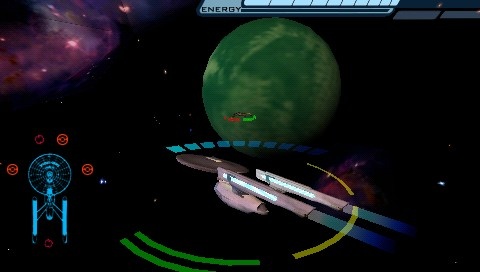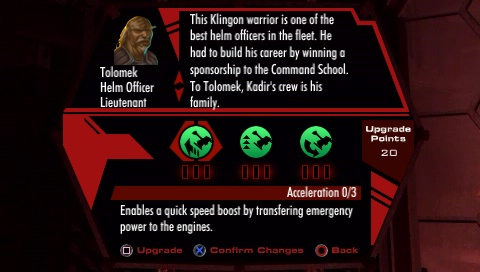There have been plenty of Star Trek games over the past few years, but the franchise has never appeared on the Sony PSP. Even better, strategy fans could look forward to adding another game to their handheld arsenal. However, Tactical Assault is not a typical strategy game. Although the original design feels fresh when you first start playing, it's also a one-trick pony that boils down to the same basic maneuvers and slow-paced combat. It also horribly overlooks its license. You'll deal with Klingons and Romulans, but the dull story and unrecognizable characters could have been used in any generic intergalactic setting.

It's too bad that the story is so dry because there's a good idea at work in Tactical Assault, which is similar to a stripped-down version of Starfleet Command. As a starship captain, you need to take multiple systems under consideration when entering battle. First and foremost are your shield facings, which are represented by arcs that circle the ship. As your opponent whittles away at your shields, rotating your ship is key to avoiding damage. You'll also want to aim for your enemy's vulnerable openings. Then, there's the issue of weapons. Each ship has two weapon types, which are mounted in various locations. Weapons have a specific firing arc, so your enemy must be within firing range of that weapon. They also have a charge-up time, so you can't just continually fire at your foes from a single stance.
The battles are a dance between you and your opponents as you maneuver your ship so that your strongest shields face your enemy while simultaneously positioning your active weapons so they can fire. For a while, it creates an interesting and methodical tug-of-war. As you progress from mission to mission, you earn new ships with more layers of shields and different weapon placements. You'll also earn upgrade points that you use to level up officers to increase your ship speed, weapon effectiveness, and more. There's an emergency power bar to watch too. If you hold the right shoulder button while moving or attacking, your action is more effective. Although it depletes some energy from your power bar, it does slowly replenish over time.
It sounds complex, but it's quite simple in practice. You essentially fire your available weapons, turn your ship so that another batch of weapons faces your enemy, fire those weapons, and repeat, ad nauseam. Even with the addition of temporary ability boosts, cloaking, and officer upgrades, it gets predictable really fast. You can scan objects or hail other ships outside of combat, but these abilities don't do anything aside from move the story along.
That is, if you can call it a story. It just boils down to a bunch of disjointed missions that recycle elements from the original Star Trek series. The Klingons hate the Federation. They infiltrate the Neutral Zone and disrupt current peace talks. The Romulans are somehow involved. The incredibly simplistic plot might be more satisfying if you got to lead Captain Kirk into battle, but you're stuck with an unfamiliar cast that is original to the game. The ships and races are all that make the franchise recognizable. It's almost as if Bethesda Softworks slapped the license on a generic space game that was already in development. Aside from affecting your end-mission rating, the multiple-choice endings that are offered with some missions don't extend beyond the mission or significantly alter the gameplay.
Some other good ideas also miss the mark. There are three status alert levels: green, yellow, and red. Green is the standard alert level; yellow raises shields; and red lets you fire weapons. While there are a few circumstances where your current alert status affects a dialogue tree, it usually serves no purpose other than to frustrate. You will enter an area at green alert and then be attacked, which will require you to press start and change to yellow or red alert. Alert levels sound like a good idea, but the need to manually activate your weapons is more annoying than tactical.
Environmental objects can cause a great deal of damage to your ship if you run into them. In theory, avoiding asteroids and using them as cover could have been a cool strategic addition. However, the third-person camera is zoomed in so closely that you often can't see them in enough time to avoid them. There's nothing like losing an entire face of shields or damaging your hull because you ran into a moon that you didn't see until it was too late. Those collisions will most likely cost you the battle, particularly in the challenging Klingon missions, because the artificial intelligence never seems to have the same problem.
Star Trek: Tactical Assault includes Federation and Klingon campaigns, as well as skirmish battles and ad hoc multiplayer with up to four ships. It's a good array of options that includes five different maps and a variety of ships at your disposal in a skirmish, including Romulan ones. There is also an additional multiplayer mode called battle fest, where each player starts in his race's smallest ship. When a player is defeated, he returns in the next biggest ship until there are no ships left in the hierarchy. The first player to run out of respawns loses. Even if it doesn't significantly alter the gameplay, it's easily the strongest mode because it adds an additional layer of enjoyment that is missing from the rest of the game.

Tactical Assault's presentation doesn't make it feel any more Trekkish, other than the impressive opening cutscene and William Shatner's awesomely laconic voice-over. And aside from the vibrant menu screens, nothing takes advantage of the PSP's capabilities. Space is noticeably bland, where the shield arcs and a few nebulae provide the majority of color. The ship models are OK, but they lack detail and character. The music does its best to set the tone. As good as it is, however, it supplies most of the sound design. The din of battle also wears thin because it's the same phaser fire over and over.
Star Trek: Tactical Assault is brimming with good ideas that just don't feel fleshed out. It's got a nice strategic concept but doesn't run far enough with it. Even with two lengthy campaigns and skirmish options, it doesn't feel quite complete. The underused license is also a shame because a little Captain Kirk goes a long way. Trekkies will find Tactical Assault worth a look, but there isn't enough Star Trek or strategy to give life to the game's promising concept.
Editor's note 11/29/06: The review originally stated that the PSP version of Tactical Assault includes a Klingon language option, which is incorrect. GameSpot regrets the error.